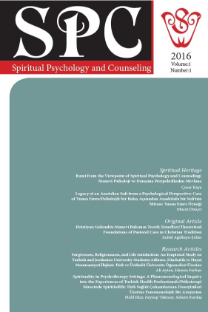Using Spiritual Genograms in Family Therapies
The genogram was developed by Bowen, a pioneer of the psychodynamic family theory, and has been used in therapies in different ways. Genogram types are named according to the area in which they are used, and spiritual genograms are one of these. Due to the increase in studies focusing on spirituality in family therapies, this research is conducted over the use of spiritual genograms as a therapeutic tool. Although Turkey has great potential for religiousness and spirituality, no study has yet been observed there on the use of spiritual genograms in the therapeutic process. This deficiency has led us to introduce spiritual genograms and provide a place for their use in therapy. This study also aims to provide information on the stages of spiritual genograms and how they should be used as a tool in therapy. Furthermore, results have been shared regarding the effect of using genograms in the therapeutic process based on sample cases employed by various researchers in therapy.
Keywords:
Spiritual genogram, Spirituality Family therapies,
___
- Bowen, M. (1978). Family therapy in clinical practice. New York, NY: Jason Aronson.
- Brody, E. E. (2003). A Premarital therapy model for Jewish-Christian interfaith couples (Doctoral dissertation, Graduate Faculty of California School of Professional Psychology Alliant International University, San Diego).
- Bullis, R. K. (1990). Spiritual genograms: Nurturing our spiritual roots. Church Teachers, 17(5), 174–175, 190–191.
- Dunn, A., & Dawes, S. (1999). Spiritual-focused genograms: Key to uncovering spiritual resources in African American families. Journal of Multicultural Counseling and Development, 27(4), 240–255.
- Erlanger, M. A. (1990). Using the Genogram with the older client. Journal of Mental Health Counseling, 12(3), 321–31.
- Frame, M. W. (2000). Spiritual genogram in family therapy. Journal of Marital and Family Therapy, 26, 211–216.
- Frame, M. W. (2001). The spiritual genogram in training and supervision. The Family Journal, 9(2), 109–115.
- Friedman, H., Rohrbaugh, M., & Krakauer, S. (1988). The timeline genogram: Highlighting temporal aspects of family relationships. Family Process, 27, 293–304.
- Gibson, D. M. (2005). The use of genograms in career counseling with elementary, middle, and high school students. The Career Development Quarterly, 53(4), 353–362.
- Halevy, J. (1998). A genogram with an attitude. Journal of Marital and Family Therapy, 24(2), 233–242.
- Hardy, K. V., & Laszloffy, T. A. (1995). The cultural genogram: Key to training culturally competent family therapists. Journal of Marital and Family Therapy, 21, 227–237.
- Haug, I. E. (1998). Spirituality as a dimension of family therapists’ clinical training. Contemporary Family Therapy, 20(4), 471–483.
- Heller, P. E., & Wood, B. (2000). The influence of religious and ethnic differences on martial intimacy: Intermarriage versus intermarriage. Journal of Marital and Family Therapy, 26(2), 241–252.
- Hodge, D. R. (2000). Spiritual ecomaps: A new diagrammatic tool for assessing marital and family spirituality. Journal of Marital and Family Therapy, 26(2), 217–228.
- Hodge, D. R. (2001). Spiritual genograms: A generational approach to assessing spirituality. Families in Society: The Journal of Contemporary Human Services, 82(1), 35–48.
- Hodge, D. R. (2003). Spiritual assessment: Handbook for helping professionals. Botsford, CT: National Association of Clinical Social Work.
- Hof, L., & Berman, E. (1986). The sexual genogram. Journal of Marital and Family Therapy, 12, 39–47.
- Işık, E., Akbaş, T., Kırdök, O., Avcı, R., & Çakır, İ. (2012). Use of the genogram technique in counseling with Turkish families. Journal of Family Psychotherapy, 23(2), 131–137. http://dx.doi.org/10.1080/08975353.2012.679903
- Kerr, M., & Bowen, M. (1988). Family evaluations: An approach based on Bowen theory. New York, NY: W.W. Norton.
- Kuehl, B. P. (1995). The solution-oriented genogram: A collaborative approach. Journal of Marital and Family Therapy, 21, 239–250.
- Lewis, K. G. (1989). The use of color-coded genograms in family therapy. Journal of Marital and Family Therapy, 15, 169–176.
- McGoldrick, M., Gerson, R., & Shellenberger, S. (1996). Genograms in family assessment (2nd ed.). New York, NY: Norton.
- McGoldrick, M., Gerson, R., & Shellenberger. (1999). Genograms: Assessment and intervention (2nd ed). New York, NY: W.W. Norton & Company.
- Miehls, D. (1993). Conjoint treatment with narcissistic couples: Strategies to increase empathic interaction. Smith College Studies in Social Work, 64(1), 3–17.
- Milewski-Hertlein, K. A. (2001). The use of a socially constructed genogram in clinical practice. The American Journal of Family Therapy, 29, 3–28.
- Sherman, R. (1993). Marital issues of intimacy and techniques for change: An Adlerian systems perspective. Individual Psychology, 49(3/4), 318–329.
- Stander, V., Piercy, F. P., MacKinnon, D., & Helmeke. K. (1994). Spirituality, religion and family therapy: Competing or complementary worlds? The American Journal of Family Therapy, 22(1), 27–41.
- Wachtel, E. F. (1982). The family psyche over three generations: The genogram revisited. Journal of Marital and Family Therapy, 8(3), 335–343.
- Wiggins, M. I. (2008). Therapist self-awareness of spirituality. In J. D. Aten & M. M. Leach (Eds.), Spirituality and the therapeutic process (pp. 53–74). Washington, DC: American Psychological Association.
- Williamson, D. S. (1981). Personal authority via termination of the intergenerational hierarchical boundary: A “new” stage in the family life cycle. Journal of Marital and Family Therapy, 7, 441–452.
- Willow, R. A., Tobin, D. J., & Toner, S. (2009). Assessment of the use of spiritual genograms in counselor education. Counseling and Values, 53, 214–223. http://dx.doi.org/10.1002/j.2161-007X.2009.tb00127.x
- ISSN: 2458-9675
- Yayın Aralığı: Yılda 3 Sayı
- Başlangıç: 2016
- Yayıncı: Halil Ekşi
Sayıdaki Diğer Makaleler
Aile Terapilerinde Manevi Genogram Kullanımı
Gabriela PİCCİOTTO, Jesse FOX, Craig S. CASHWELL, Félix NETO
Çocuk Kaybı Yaşayan Ailelerle Manevi Danışmanlık
Gabriela PİCCİOTTO, Jesse FOX, Craig S. CASHWELL, Félix NETO
Gabriela PİCCİOTTO, Jesse FOX, Craig S. CASHWELL, Félix NETO
Anne Manevi Başa Çıkma Ölçeği: Geliştirme ve Geçerlik Çalışması
K. Gamze YAMAN, Hatice SANVER GÜRSOY, A. Nilgün CANEL, Halil EKŞİ
Suça Sürüklenen Çocuklarda Manevi Müdahaleler
K Gamze YAMAN, Hatice SANVER GÜRSOY, A. Nilgün CANEL, Halil EKŞİ
